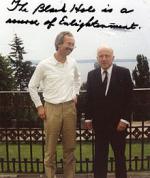Disable ads!
John Archibald Wheeler
John Archibald Wheeler (July 9, 1911 – April 13, 2008) was an American theoretical physicist. He was largely responsible for reviving interest in general relativity in the United States after World War II. Wheeler also worked with Niels Bohr in explaining the basic principles behind nuclear fission. Together with Gregory Breit, Wheeler developed the concept of Breit–Wheeler process. He is also known for popularizing the term "black hole", for coining the terms "neutron moderator", "quantum foam", "wormhole", and "it from bit", and for hypothesizing the "one-electron universe". Wheeler earned his doctorate at Johns Hopkins University under the supervision of Karl Herzfeld, and studied under Breit and Bohr on a National Research Council fellowship. In 1939 he teamed up with Bohr to write a series of papers using the liquid drop model to explain the mechanism of fission. During World War II, he worked with the Manhattan Project's Metallurgical Laboratory in Chicago, where he helped design nuclear reactors, and then at the Hanford Site in Richland, Washington, where he helped DuPont build them. He returned to Princeton after the war ended, but returned to government service to help design and build the hydrogen bomb in the early 1950s. For most of his career, Wheeler was a professor at Princeton University, which he joined in 1938, remaining until his retirement in 1976. At Princeton he supervised 46 PhDs, more than any other professor in the Princeton physics department. He was influential in mentoring a generation of physicists of the Golden Age of General Relativity, who made notable contributions to quantum mechanics and gravitation.
 Read more on wikipedia.org Read more on wikipedia.org
 All quotes by John Archibald Wheeler All quotes by John Archibald Wheeler
 Edit Edit
|

|
|
|
|
|
Background photo by Giuliana
|